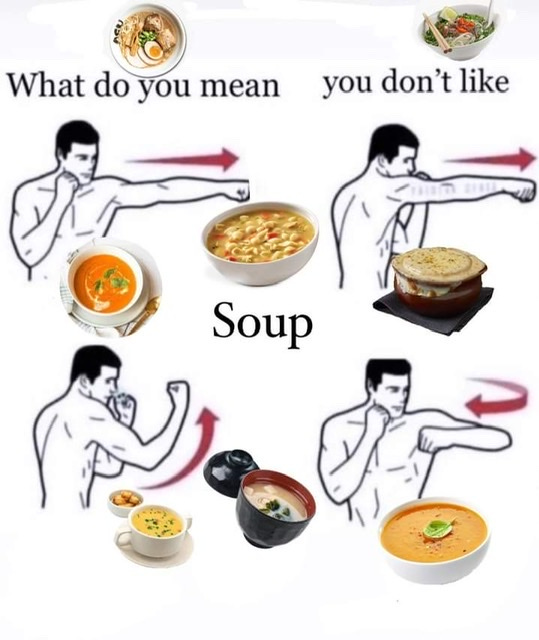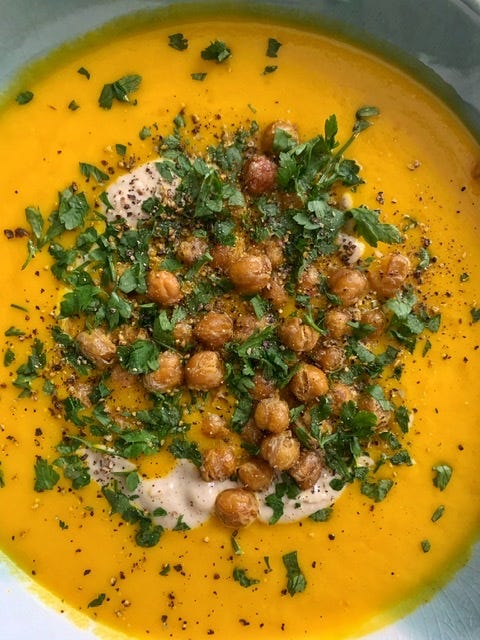Is it a soup?
An important investigation into soup classification, plus a recipe for the highly delicious yet unassuming crema de calabacín (zucchini cream)
As you’ve probably seen online, the world has declared that it’s soup season. For me, soup season is every season (see: salmorejo and gazpacho), but I understand the sentiment. There’s nothing better than a steaming bowl of soup enjoyed on a crisp fall (or frigid winter) day.
When I was younger, I had a very limited repertoire of soups that I would actually eat. My soup selections consisted of Campbell’s chicken noodle, my mom’s beef and vegetable soup (just called “soup” in our household, much like David and I call the lentil soup we make simply “lentejas”), and Top Ramen—chicken flavor only1, and always served with the perfect ratio of broth to noodle, even though I never actually ate the broth part.

My mom made other soups, too, of course: beef stew, variations on bean soups, and tomato soup, among others. I just didn’t like any of them. Or sometimes I would eat only one element of the meal. I remember sitting in front of a bowl of what my family called “Lima Beans and Polish Sausage” (which is exactly what it sounds like), meticulously picking out the half-circles of kielbasa deemed worthy of my consumption, while leaving the rejected stewed beans behind. But if my mom cooked Polish sausage on its own, cut in the same shape and size, yet didn’t stew it in the beans before serving it to me? Forget it, not eating it. Did I mention I was a spoiled child?
I tell this backstory mostly to contrast with the fact that today I love soup in all forms (and maybe to give parents of picky eaters reassurance that their kid will most likely emerge from childhood eating more than frozen pizza and chicken nuggets). Now that I think of it, soup should probably be included in my answer for the Name Your Top Five Foods question that I talked about last week.
It’s important to note that I’m using the term “soup” as a categorical word that includes broths, creams, purées, stews, etc. In talking with David, this is apparently not as common here in Spain (or at least not in his family); people mostly likely wouldn’t use the word sopa (soup) when talking about a puré de calabaza (pumpkin purée). On the other hand, I feel like using “soup” in this way is fairly customary in the US (or maybe I’m wrong and it’s just me?).

In thinking about my discussion with David, it reminded me of the incredibly random debate from several years ago that can summarized by the question “Is it a sandwich?”. Unsurprisingly (this is the Internet, after all), there’s a whole website called The Cube Rule dedicated to the debate, as well as a Sandwich Alignment Chart (found on the same website) to help you decide if you are, in fact, eating a sandwich, or maybe you’re mistaken and it’s actually sushi on your plate.
I started wondering if there was an equivalent classification system for soup. And of course there is, courtesy of a random Reddit post from five years ago:
No offense to the person who made this, but I’m not sure that I’m entirely on board with their assessment. For example, I don’t think a TRUE SOUP must have noodles. But it’s a good jumping off point, and I do like the PURE ANARCHY of chocolate fondue.
Here’s a breakdown of some Spanish terms and dishes according to the chart above:
Caldo (broth): Structural purity, neutral ingredients
Sopa (broth with noodles, usually fideos): TRUE SOUP
Crema (defined by the RAE as a “thick soup”): Structural purity, neutral ingredients
Puré (defined by the RAE as “a paste made of vegetables and other ‘edible things’ cooked and crushed/blended”: Structural purity, neutral ingredients
Guiso (stew): True Neutral
Estofado (defined by the RAE as “a stew consisting of a food seasoned with oil, wine or vinegar, garlic, onion, and various spices, that is placed fully raw into a covered pot to cook over slow heat without loosing steam or aroma”): True Neutral
Cocido (a traditional Spanish dish with ingredients cooked all in the same pot but usually served in three courses: first the broth with fideos, then chickpeas and vegetables, and finally the meats—typically including chicken, beef, ham, and chorizo):
First course- TRUE SOUP
Second course- Neutral structure, ingredient purity; True Neutral; or Structural anarchy, ingredient purity, depending on if you have any broth and/or fideos left over from the first course
Third course- Structural anarchy, neutral ingredients (although at this point you’ll be so full that you won’t care anymore)
After (too) much consideration, I’ve decided that this whole soup business needs to be reworked to fit Spanish standards. If you tell me that a puré and a crema are similar enough to be in the same category, te lo compro2, but a caldo and a crema? I’m not so sure. I think this calls for a part two in which I investigate this further. More on this later.
This is how much I love soup: When I visited David in Spain for the first time in 2014, I tried tons of new and exciting foods that I liked. I could have asked him to send me a recipe for paella, or tortilla, or even empanada. But what recipe did I ask him for? Crema de calabacín.

Crema de calabacín (zucchini cream in English) is an unassuming soup. I tried to look up a bit of the history behind it here in Spain, but it’s so modest that I couldn’t find much worth reporting.3 That doesn’t mean that it’s not delicious. In fact, the best (and funniest) thing that I found in my Google investigation of the dish was this intro to a blog post/recipe from 2012:
Les presento la crema de calabacín, una de esas recetas que un día tu mujer te sirve obedeciendo los consejos del endocrino y que, al probarla, te quedas perplejo hasta que dices: “¡Coño, qué bueno está esto!”
(I present to you zucchini cream, one of those recipes that your wife serves you following the recommendation of your endocrinologist and, after you try it, you’re so surprised that you say: “F**k, this is amazing!”)
It is, indeed, amazing. It’s also simple, and since zucchini is in season here in Spain through October, it’s the perfect transitional soup from summer to fall. I prefer to eat it warm year-round but you can also serve it cold, which makes it even more versatile. And it’s apparently endocrinologist-approved. What more could you want?!
Check out our house recipe below! Your bloodwork (and stomach) will thank you.
Crema de calabacín (Zucchini cream)
Yield: Around 10 servings of 380g each, or possibly more depending on actual quantities of liquid used/cook time. Definitely halve the recipe if you’re not making it for a crowd or planning on freezing it!
Special equipment needed
Peeler for vegetables
Cutting board and knife
Large pot or Dutch oven
Blender (we use a high speed vintage Thermomix, but a regular blender should work fine)
Ingredients
70g butter (can sub for olive oil to make it fully dairy-free/vegan)
15g olive oil
500g leek, white part only, thinly sliced
1 kg potato, peeled and cut into large chunks
1.2 kg zucchini, peeled and cut into large chunks
1.5 liters vegetable broth
400 ml oat milk (can sub for regular milk or plant-based milk of choice)
1 tbsp salt (divided), plus more to taste
1 tsp white pepper, plus more to taste
Directions
Heat butter and oil on medium heat.
When hot, add leeks and sauté for about 5 minutes.
Add potatoes, zucchini, and 1/2 tbsp of the salt (so half of amount listed) and cook for another 10 minutes.
Add vegetable broth, milk, remaining salt (1/2 tbsp), and bring to boil.
Once boiling, lower heat, cover, and simmer for 25 minutes.
When the soup is ready (potatoes and zucchini should be easily pierced with a fork), remove from heat and let cool slightly.
Using blender of choice, blend soup in batches.
Combine batches into one large bowl.
Taste and add additional salt and pepper if needed before serving. You can also add more broth/oat milk here if the soup appears too thick for your liking.
I hope you’ve enjoyed this hardcore investigation into soup and the accompanying zucchini cream recipe! I’ll be back next Wednesday with part two, hopefully with a handy flowchart to solve any Spanish soup incertitude. In the meantime, please let me know if you have questions, any thoughts on soup classification, or if you’ve ever mistaken sushi for a sandwich. Comments are open below!
Hasta luego!4
Ki
On Top Ramen flavors: Once my mom accidentally bought beef flavor instead and thought I wouldn’t notice, but she was wrong (sorry, Mom, and thank you for putting up with me).
Te lo compro: You’ve convinced me
On research into zucchini cream: I’m sure if I did some digging in an actual library, I would find more information. Zucchini cream history just isn’t provocative enough to come up in a Google search.
Hasta luego: See you later




Yes you were a very picky eater! But we managed to get you to eat! I remember making grilled cheese sandwiches which I would have to cut into 4 pieces before you would eat it. You said it didn’t taste the same uncut. So I guess presentation does make a difference!
Hello Kiki! Thanks for this lovely post :)
Boyfriend hates soups... but when it's time to eat them, because I do love a soup and make it often at home, he always ends the meal very happy and satisfied. He just doesn't like the concept of it lol 😆 this zucchini valoutée sounds like a good idea to use up the last of the summer surviving veggies (not sure we have leek around already though, might use onion)